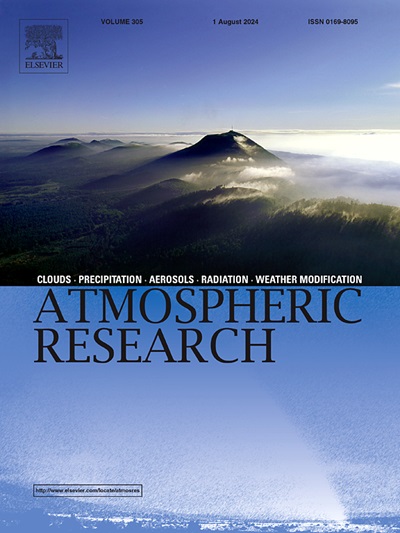热带气旋引起的降雨变异及其对台湾干旱的影响:从 1981 年到 2022 年的观察
IF 4.5
2区 地球科学
Q1 METEOROLOGY & ATMOSPHERIC SCIENCES
引用次数: 0
摘要
本研究利用 CHIRPS、FLDAS、IBTrACS 数据以及哨兵和大地遥感卫星图像,分析了 1981 年至 2022 年期间台湾热带气旋(TC)与干旱之间的相互作用。我们的研究结果表明,在过去十年中,由热带气旋引起的降雨量明显减少,并在 2017 年出现了一个转折点。我们在热带气旋引发的降雨和随后的春季土壤水分水平之间建立了中低度的正相关关系,其中四月份的关系最为密切。在从农业区向森林区过渡的过程中,这种关系会加强。此外,我们的研究还发现,热带气旋引发的降雨量与水库水位之间存在密切的相关性(r = 0.77),这凸显了热带气旋与水文干旱之间的一致联系。然而,在水供应模式方面出现了耐人寻味的差异。2007 年和 2020 年,尽管前几年的台风降雨量减少,但水库水位保持正常。相反,在 2019 年,尽管有典型的热带风暴引起的降雨,但仍出现了水资源短缺。这些案例表明,供水量受到热带风暴以外因素的影响,包括水需求、基础设施、季风和春季降雨、气温以及水资源管理策略。此外,我们还发现热带气旋与季风引起的降雨之间存在对称关系,这表明它们具有平衡水库供水的潜力。然而,在过去十年中,气旋和季风都呈现出下降趋势,加剧了台湾春季缺水的风险。有效的水资源管理需要考虑自然和人为因素,包括土地利用变化、森林砍伐、生产活动、水污染和政策策略。这些措施对于缓解台湾缺水问题和促进可持续发展至关重要。本文章由计算机程序翻译,如有差异,请以英文原文为准。
Tropical cyclone-induced rainfall variability and its implications for drought in Taiwan: Insights from 1981 to 2022
This study analyzes the interplay between tropical cyclones (TCs) and drought in Taiwan over the period from 1981 to 2022, leveraging data from CHIRPS, FLDAS, IBTrACS, and Sentinel and Landsat satellite imagery. Our findings reveal a significant decline in TC-induced rainfall over the last decade, with a turning point in 2017. We establish a low to moderate positive correlation between TC-induced rainfall and subsequent spring soil moisture levels, with April exhibiting the strongest connection. This relationship strengthens in transitions from agricultural to forested areas. Additionally, our research identifies a robust correlation (r = 0.77) between TC-induced rainfall and reservoir water levels, underscoring the consistent link between TCs and hydrological drought. However, intriguing disparities emerge in water availability patterns. In 2007 and 2020, reservoirs maintained normal levels despite reduced typhoon rainfall in prior years. Conversely, in 2019, water shortages occurred despite typical TC-induced rainfall. These cases suggest that water availability is influenced by factors beyond TCs, including water demand, infrastructure, monsoon and spring rainfall, air temperature, and water management strategies. Furthermore, we uncover a symmetrical relationship between TCs and monsoon-induced rainfall, indicating their potential to balance reservoir water supply. Nevertheless, both TCs and the monsoon exhibit declining trends in the past decade, heightening the risk of spring season water scarcity in Taiwan. Effective water resource management demands consideration of natural and anthropogenic factors, encompassing land use changes, deforestation, production activities, water pollution, and policy strategies. These measures are essential to mitigate water scarcity and promote sustainability in Taiwan.
求助全文
通过发布文献求助,成功后即可免费获取论文全文。
去求助
来源期刊

Atmospheric Research
地学-气象与大气科学
CiteScore
9.40
自引率
10.90%
发文量
460
审稿时长
47 days
期刊介绍:
The journal publishes scientific papers (research papers, review articles, letters and notes) dealing with the part of the atmosphere where meteorological events occur. Attention is given to all processes extending from the earth surface to the tropopause, but special emphasis continues to be devoted to the physics of clouds, mesoscale meteorology and air pollution, i.e. atmospheric aerosols; microphysical processes; cloud dynamics and thermodynamics; numerical simulation, climatology, climate change and weather modification.
 求助内容:
求助内容: 应助结果提醒方式:
应助结果提醒方式:


